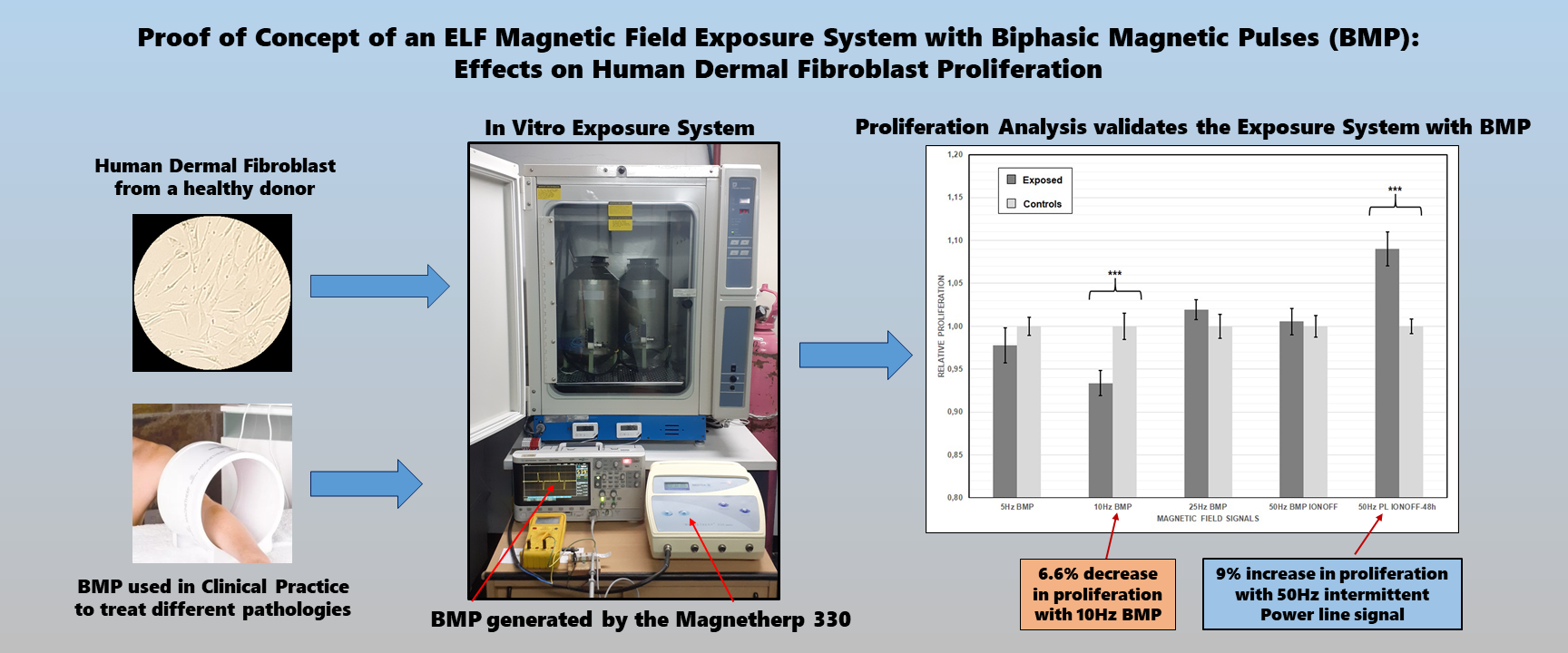Proof of Concept of an ELF Magnetic Field Exposure System with Biphasic Magnetic Pulses: Effects on Human Dermal Fibroblast Proliferation
Keywords:
biphasic magnetic pulses, extremely low frequencies, human dermal fibroblast, in vitro exposure, proliferation assessmentAbstract
The aim of this work was to validate the usefulness of an Extremely Low Frequency (ELF) magnetic field exposure system with a magnetotherapy device of common use in clinical practice that generates Biphasic Magnetic Pulses (BMP), in order to study the effects of the BMP on the proliferation of Human Dermal Fibroblasts (HDF). In that regard, HDF were exposed 2h in the morning and 2h in the afternoon for 2 days to BMP of 1.41mT peak value at 5, 10, 25Hz continuous and 50Hz intermittent (2s on/ 1.5s off). MTT assay was performed to assess proliferation. The 10Hz BMP showed a significant decrease in proliferation of 6.6% (p = 0.001) with respect to controls, but no significant changes in proliferation were seen with the other BMP. In order to analyze whether these results could be related to the exposure protocol, a 50Hz power line intermittent signal (1s on/ 1s off) was generated and tested but exposure time was increased to 48h to cover the complete cells doubling time. A significant increase in proliferation of 9% (p < 0.001) was found in this case. The results validate the in vitro exposure system for its use with the BMP. Though the MTT proliferation assay alone is not enough to make definitive claims, the results might indicate that exposure time plays a key role in the outcome of the experiments. Therefore, special attention should be paid to the exposure time on in vitro protocols and how they relate to in vivo experiments and current treatments.
Downloads
References
S. M. Ross, “Combined DC and ELF Magnetic Fields Can Alter Cell Proliferation,” Bioelectromagnetics., vol. 11, no. 1, pp. 27-36, 1990.
F. Pezzetti, M. De Mattei, A. Caruso, R. Cadossi, P. Zucchini, F. Carinci, G. C. Traina and V. Sollazzo, “Effects of Pulsed Electromagnetic Fields on Human Chondrocytes: An In Vitro Study,” Calcif Tissue Int., vol. 65, no. 5, pp. 396-401, Nov. 1999.
G. Olsson, I. Y. Belyaev, T. Helleday and M. Harms-Ringdahl, “ELF magnetic field affects proliferation of SPD8/V79 Chinese hamster cells but does not interact with intrachromosomal recombination,” Mutat Res., vol. 493, no. 1–2, pp. 55–66. Jun. 2001.
G. Hannay, D. Leavesley and M. Pearcy, “Timing of Pulsed Electromagnetic Field Stimulation Does Not Affect the Promotion of Bone Cell Development,” Bioelectromagnetics., vol. 26, no. 8, pp. 670-676, Sep. 2001.
C. Seeliger, K. Falldorf, J. Sachtleben and M. Van Griensven, “Low-frequency pulsed electromagnetic fields significantly improve time of closure and proliferation of human tendon fibroblasts,” Eur J Med Res, vol. 19, no. 1, pp. 37-42, Jul. 2014.
L. Makinistian, E. Marková and I. Belyaev, “A high throughput screening system of coils for ELF magnetic fields experiments: proof of concept on the proliferation of cancer cell lines,” BMC Cancer., vol. 19:188, Feb. 2019.
M. Markov, “XXIst century magnetotherapy,” Electromagn Biol Med., vol. 34, no. 3, pp.190-196, Sep. 2015.
I. Delvendahl, N. Gattinger, T. Berger, B. Gleich, H. R. Siebner and V. Mall, “The Role of Pulse Shape in Motor Cortex Transcranial Magnetic Stimulation Using Full-Sine Stimuli,” Plos ONE., vol. 9, no. 12, pp. 115-247, Dec. 2014.
M. A. Kisiel and S. Klar, “Isolation and Culture of Human Dermal Fibroblasts,” in Skin Tissue Engineering, New York, NY, USA: Springer Science + Business Media, 2019, pp. 71-78, May.
L. Vives, J. Balsalobre, T. Monteiro, J. García Díaz, G. Liponetzky, M. Ielpi, N. Dalmas Di Giovanni, “ELF Magnetic Field Exposure System for In Vitro Studies Based on Lee‐Whiting Coils,” Bioelectromagnetics., vol. 41, no. 5, pp. 382-391, Jun. 2020.
H. Huang, H. Lin, X. Zhang and J. Li, “Resveratrol reverses temozolomide resistance by downregulation of MGMT in T98G glioblastoma cells by the NF-κB-dependent pathway,” Oncol Rep., vol. 27, no. 6, pp. 2050-2056, Jun. 2012.
M. Zhang, X. Li, L. Bai, K. Uchida, W. Bai, B. Wu, W. Xu, H. Zhu and H. Huang, “Effects of Low Frequency Electromagnetic Field on Proliferation of Human Epidermal Stem Cells: An In Vitro Study,” Bioelectromagnetics., vol. 34, no. 1, pp. 74-80, Jan. 2013.
G. Z. An, H. Xu, Y. Zhou, L. Du, X. Miao, D. P. Jiang, K. C. Li, G. Z. Guo, C. Zhang and G. R. Ding, “Effects of Long-Term 50Hz Power-Line Frequency Electromagnetic Field on Cell Behavior in Balb/c 3T3 Cells,” Plos ONE., vol. 10, no. 2, pp. 1-13, Feb. 2015.
F. Wang, Y. Mao, Q. You, D. Hua and D. Cai, “Piperlongumine induces apoptosis and autophagy in human lung cancer cells through inhibition of PI3K/Akt/mTOR pathway,” Int J Immunopathol Pharmacol., vol. 28, no. 3, pp. 362-373, Aug. 2015.
C. A. Bassett, R. J. Pawluk and A. A. Pilla, “Augmentation of bone repair by inductively coupled electromagnetic fields,” Science., vol. 184, no. 4136, pp. 575-577, May. 1974.
O. Patiño, D. Grana, A. Bolgiani, G. Prezzavento, J. Miño, A. Merlo and F. Benaim, “Pulsed electromagnetic fields in experimental cutaneous wound healing in rats,” J Burn Care Rehabil., vol. 17, no. 6, pp. 528-531, Mar. 1996.
A. Athanasiou, S. Karkambounas, A. Batistatou, E. Lykoudis, A. Katsaraki, T. Kartsiouni, A. Papalois and A. Evangelou, “The effect of pulsed electromagnetic fields on secondary skin wound healing: an experimental study,” Bioelectromagnetics., vol. 28, no. 5, pp. 362-368, Jul. 2007.


